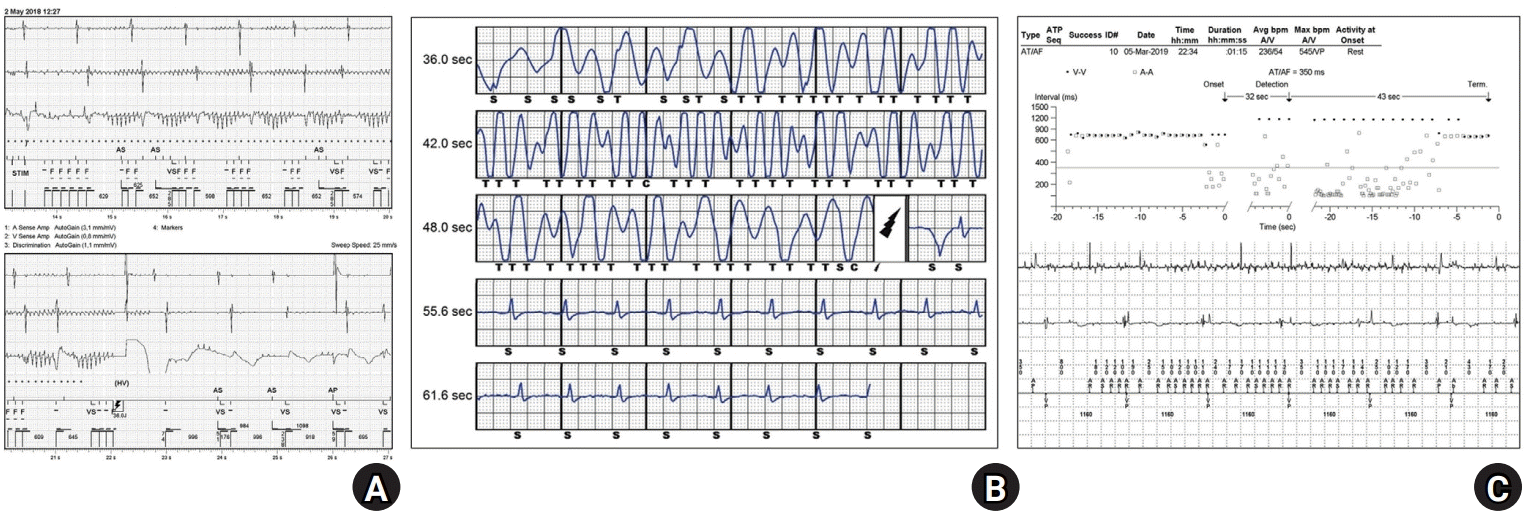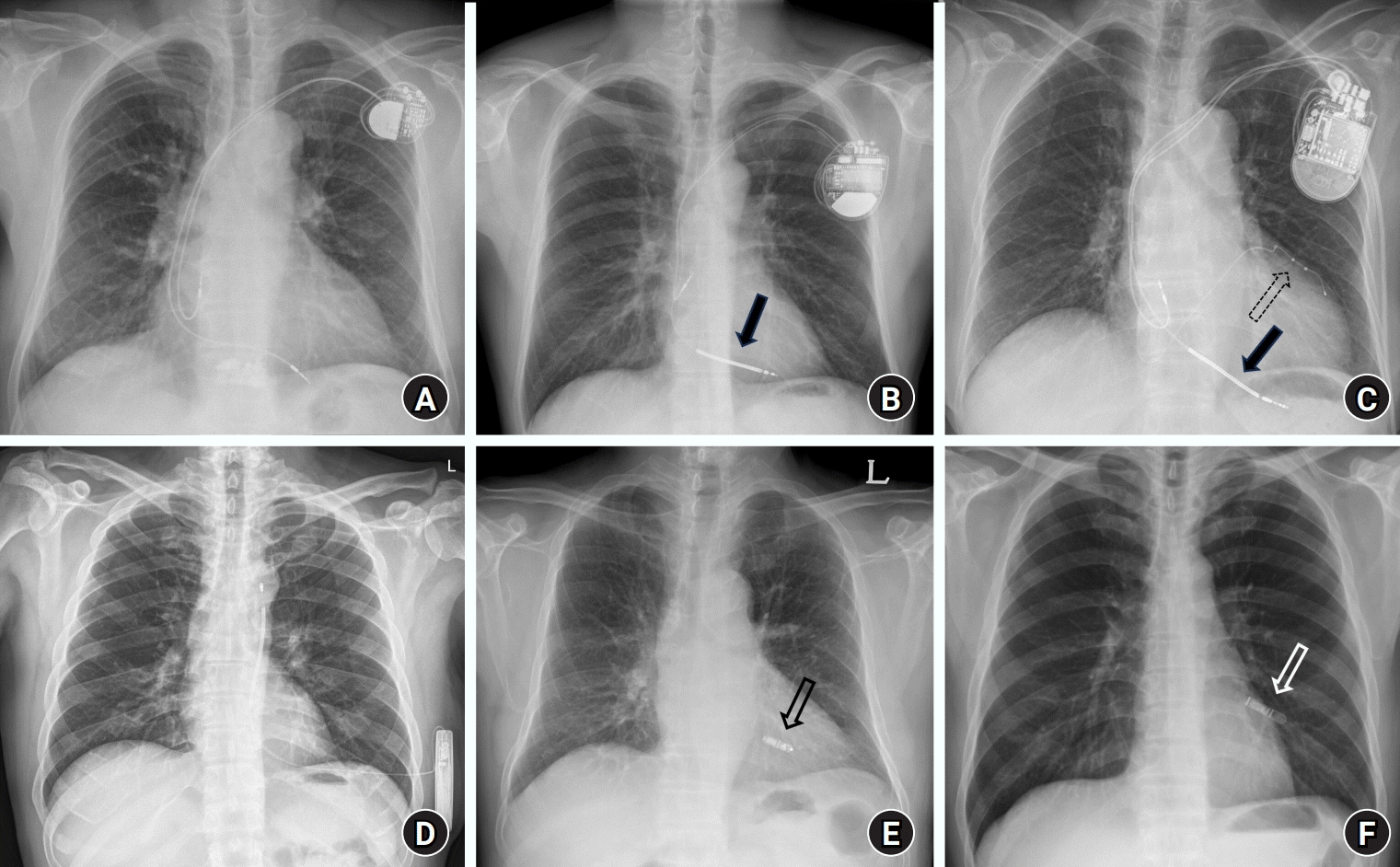1. Greenspon AJ, Patel JD, Lau E, Ochoa JA, Frisch DR, Ho RT, et al. 16-year trends in the infection burden for pacemakers and implantable cardioverter-defibrillators in the United States 1993 to 2008. J Am Coll Cardiol. 2011; 58:1001–6.
2. Voigt A, Shalaby A, Saba S. Continued rise in rates of cardiovascular implantable electronic device infections in the United States: temporal trends and causative insights. Pacing Clin Electrophysiol. 2010; 33:414–9.

3. Bharati S, Lev M. Pathology of atrioventricular block. Cardiol Clin. 1984; 2:741–51.

4. Zoob M, Smith KS. The aetiology of complete heart-block. Br Med J. 1963; 2:1149–53.
5. Cheung CC, Mori S, Gerstenfeld EP. Iatrogenic atrioventricular block. Card Electrophysiol Clin. 2021; 13:711–20.

6. Yeung C, Baranchuk A. Diagnosis and treatment of lyme carditis: JACC review topic of the week. J Am Coll Cardiol. 2019; 73:717–26.
7. Yada H, Soejima K. Management of arrhythmias associated with cardiac sarcoidosis. Korean Circ J. 2019; 49:119–33.

8. Tselios K, Gladman DD, Harvey P, Su J, Urowitz MB. Severe brady-arrhythmias in systemic lupus erythematosus: prevalence, etiology and associated factors. Lupus. 2018; 27:1415–23.

9. Behar S, Zissman E, Zion M, Goldbourt U, Reicher-Reiss H, Shalev Y, et al. Complete atrioventricular block complicating inferior acute wall myocardial infarction: short- and long-term prognosis. Am Heart J. 1993; 125:1622–7.

10. Zeppenfeld K, Tfelt-Hansen J, de Riva M, Winkel BG, Behr ER, Blom NA, et al. 2022 ESC Guidelines for the management of patients with ventricular arrhythmias and the prevention of sudden cardiac death. Eur Heart J. 2022; 43:3997–4126.
11. Bardy GH, Smith WM, Hood MA, Crozier IG, Melton IC, Jordaens L, et al. An entirely subcutaneous implantable cardioverter-defibrillator. N Engl J Med. 2010; 363:36–44.

12. Poole JE, Prutkin JM. Subcutaneous implantable cardioverter-defibrillator finding a place in sudden cardiac death prevention: emerging or emerged? J Am Coll Cardiol. 2017; 70:842–4.
13. Auricchio A, Stellbrink C, Block M, Sack S, Vogt J, Bakker P, et al. Effect of pacing chamber and atrioventricular delay on acute systolic function of paced patients with congestive heart failure. The Pacing Therapies for Congestive Heart Failure Study Group. The Guidant Congestive Heart Failure Research Group. Circulation. 1999; 99:2993–3001.

14. Glikson M, Nielsen JC, Kronborg MB, Michowitz Y, Auricchio A, Barbash IM, et al. 2021 ESC Guidelines on cardiac pacing and cardiac resynchronization therapy. Eur Heart J. 2021; 42:3427–520.
15. Krahn AD, Klein GJ, Skanes AC, Yee R. Insertable loop recorder use for detection of intermittent arrhythmias. Pacing Clin Electrophysiol. 2004; 27:657–64.

16. Bernstein AD, Daubert JC, Fletcher RD, Hayes DL, Lüderitz B, Reynolds DW, et al. The revised NASPE/BPEG generic code for antibradycardia, adaptive-rate, and multisite pacing. North American Society of Pacing and Electrophysiology/British Pacing and Electrophysiology Group. Pacing Clin Electrophysiol. 2002; 25:260–4.
17. Gifford J, Larimer K, Thomas C, May P. ICD-ON registry for perioperative management of CIEDs: most require no change. Pacing Clin Electrophysiol. 2017; 40:128–34.

18. Peters RW, Gold MR. Reversible prolonged pacemaker failure due to electrocautery. J Interv Card Electrophysiol. 1998; 2:343–4.
19. Schimpf R, Wolpert C, Herwig S, Schneider C, Esmailzadeh B, Lüderitz B. Potential device interaction of a dual chamber implantable cardioverter defibrillator in a patient with continuous spinal cord stimulation. Europace. 2003; 5:397–402.

20. Shenoy A, Sharma A, Achamyeleh F. Inappropriate ICD discharge related to electrical muscle stimulation in chiropractic therapy: a case report. Cardiol Ther. 2017; 6:139–43.

21. Paniccia A, Rozner M, Jones EL, Townsend NT, Varosy PD, Dunning JE, et al. Electromagnetic interference caused by common surgical energy-based devices on an implanted cardiac defibrillator. Am J Surg. 2014; 208:932–6.

22. Tong NY, Ru HJ, Ling HY, Cheung YC, Meng LW, Chung PC. Extracardiac radiofrequency ablation interferes with pacemaker function but does not damage the device. Anesthesiology. 2004; 100:1041.

23. Kitajima A, Nakatomi T, Otsuka Y, Sanui M, Lefor AK. Cardiac arrest due to failed pacemaker capture after peripheral nerve blockade with levobupivacaine: a case report. A A Pract. 2021; 15:e01445.

24. Dohrmann ML, Goldschlager NF. Myocardial stimulation threshold in patients with cardiac pacemakers: effect of physiologic variables, pharmacologic agents, and lead electrodes. Cardiol Clin. 1985; 3:527–37.

25. Umei TC, Awaya T, Okazaki O, Hara H, Hiroi Y. Pacemaker malfunction after acute myocardial infarction in a patient with wrap-around left anterior descending artery supplying the right ventricular apex. J Cardiol Cases. 2018; 18:9–12.

26. Korantzopoulos P, Letsas KP, Grekas G, Goudevenos JA. Pacemaker dependency after implantation of electrophysiological devices. Europace. 2009; 11:1151–5.

27. Le KY, Sohail MR, Friedman PA, Uslan DZ, Cha SS, Hayes DL, et al. Impact of timing of device removal on mortality in patients with cardiovascular implantable electronic device infections. Heart Rhythm. 2011; 8:1678–85.

28. Manegold JC, Israel CW, Ehrlich JR, Duray G, Pajitnev D, Wegener FT, et al. External cardioversion of atrial fibrillation in patients with implanted pacemaker or cardioverter-defibrillator systems: a randomized comparison of monophasic and biphasic shock energy application. Eur Heart J. 2007; 28:1731–8.

29. Kozlowski FH, Brady WJ, Aufderheide TP, Buckley RS. The electrocardiographic diagnosis of acute myocardial infarction in patients with ventricular paced rhythms. Acad Emerg Med. 1998; 5:52–7.

30. Kaplan RM, Wasserlauf J, Bandi RH, Lange EM, Knight BP, Kim SS. Inappropriate defibrillator shock during gynecologic electrosurgery. HeartRhythm Case Rep. 2018; 4:267–9.

31. Rozner MA, Kahl EA, Schulman PM. Inappropriate implantable cardioverter-defibrillator therapy during surgery: an important and preventable complication. J Cardiothorac Vasc Anesth. 2017; 31:1037–41.

32. Dimitri H, John B, Young GD, Sanders P. Fatal outcome from inappropriate defibrillation. Europace. 2007; 9:1059–60.

33. Practice advisory for the perioperative management of patients with cardiac implantable electronic devices: pacemakers and implantable cardioverter-defibrillators 2020: an updated report by the American Society of Anesthesiologists Task Force on perioperative management of patients with cardiac implantable electronic devices: Erratum. Anesthesiology. 2020; 132:938. Erratum for: Anesthesiology 2020; 132: 225-52.
34. Lamas GA, Antman EM, Gold JP, Braunwald NS, Collins JJ. Pacemaker backup-mode reversion and injury during cardiac surgery. Ann Thorac Surg. 1986; 41:155–7.

35. Gifford J, Larimer K, Thomas C, May P, Stanhope S, Gami A. Randomized controlled trial of perioperative ICD management: magnet application versus reprogramming. Pacing Clin Electrophysiol. 2014; 37:1219–24.

36. Crossley GH, Poole JE, Rozner MA, Asirvatham SJ, Cheng A, Chung MK, et al. The Heart Rhythm Society (HRS)/American Society of Anesthesiologists (ASA) Expert Consensus Statement on the perioperative management of patients with implantable defibrillators, pacemakers and arrhythmia monitors: facilities and patient management this document was developed as a joint project with the American Society of Anesthesiologists (ASA), and in collaboration with the American Heart Association (AHA), and the Society of Thoracic Surgeons (STS). Heart Rhythm. 2011; 8:1114–54.

37. Pinski SL, Trohman RG. Interference in implanted cardiac devices, part II. Pacing Clin Electrophysiol. 2002; 25:1496–509.







 PDF
PDF Citation
Citation Print
Print



 XML Download
XML Download